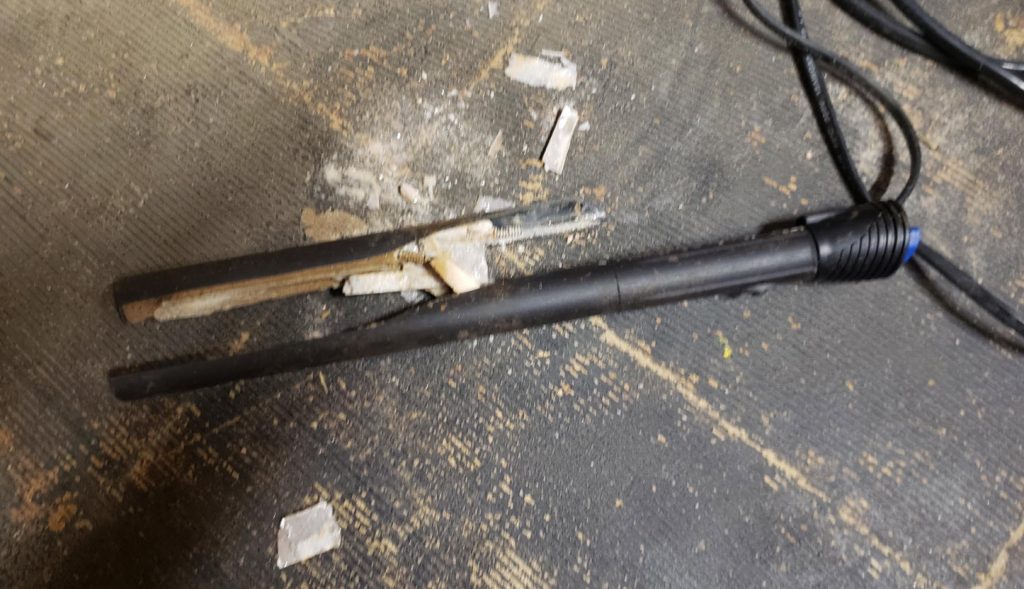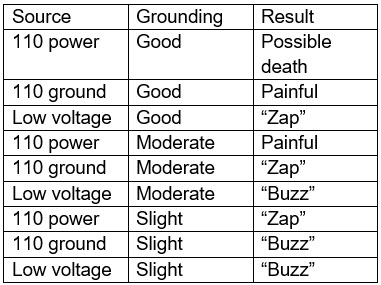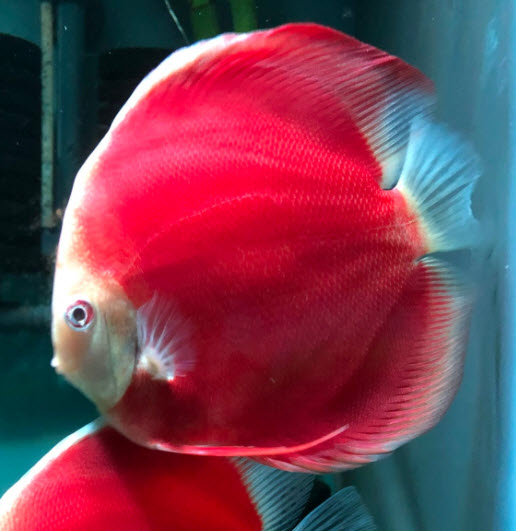
All experienced fish keepers have screwed up and shorted out a heater in the aquarium. The typical scenario is that a hobbyist drops the water level in their tank by 50% to do a water change and forgets to turn off the heater. When the hobbyist then adds a bucket of water back into the aquarium the heater explodes in a flash of light and smoke and the circuit breaker blows. And the fish are not electrocuted!
This is simply because it is very difficult to electrocute a fish in an aquarium. It’s almost impossible!

Note that it is very common to have a heater stick in the ON position and heat the water up to over 100 degrees and literally “cook” the fish. The heater will then overheat to the point of shorting out and stop working. The temperature in the tank then falls over time. But the fish are still dead. The hobbyist finds the dead fish and a “electrical smell” from a now shorted heater, and the hobbyist comes on social media saying is fish were “electrocuted”. The fish were not electrocuted, they were cooked.

The Human Analogy
But wait you say. On TV just last night someone was murdered by dropping an appliance into a bathtub. It turns out this is great entertainment but not very true to life. Examining this phenomenon is very useful when looking at fish electrocution in an aquarium.
The U.S. Consumer Product Safety Commission research said that in the United States in the ten years from 1992 to 2002 there were a total of 180 electrocution deaths by all consumer appliances (http/www.cpsc.gov/library/2002electrocutions.pdf).
There are no electrocutions listed for hairdryers or radios. Hairdryers and radios are normally what falls into a bathtub. This is 18 deaths from all types of consumer appliance electrocutions per year across the entire USA. That is not a high incidence of death, even if all these deaths were bathtub electrocutions, which they aren’t.

The TV show Mythbusters did an episode on electrocution in the bathtub. It turns out it is POSSIBLE to get electrocuted in a bathtub, but several things must occur simultaneously:
- The appliance needs to land in the water opposite the drain location for the path of least resistance to be through the body.
- There is a power side and a ground side to household electrical lines. Both sides are typically exposed inside any appliance. In order to electrocute a person the ground side to the circuit must somehow be insulated from the water while the power side is not insulated.
- The outlet the appliance is plugged into must have no GFI (ground fault interrupter).
- The water must have a small amount of salts in it to allow enough current to pass through the water.
- The appliance needs to have a decent amount of exposed charged surface area to pass enough current into the water (the saltier the water the less surface area is required)
- The voltage needs to be 110-volt household current. A cell phone being charged with five volts of power will not cause death if dropped into the bathtub.
The current flow in a bathtub death is from the appliance, through the water to the human, through the human (including the heart), out through the water, and down the drain to ground.
If the appliance is dropped in the same end of the bathtub as the drain, little current will pass into and through the human. The TV show Mythbusters tested this scenario and they concluded it is impossible to be electrocuted by an appliance which is not dropped on the far side of the heart from the drain in a bathtub.

Aquarium Electrocution
There isn’t a drainpipe on most aquariums. Therefore, there is no ground on most aquariums. So, the flow in a broken aquarium heater is confined to a flow from one side of the heater element to the other side of the heater element. The flow can’t pass THROUGH any fish. Therefore, there is virtually no way to electrocute an aquarium fish.
Now some nitpicking naysayer will come up with the following scenario:
- A wavemaker on one side of an aquarium gets a frayed electrical cord on the power side of a household circuit.
- Another wavemaker on the opposite side of the aquarium gets a frayed electrical cord on the ground side of a household circuit.
- The hobbyist has added some salt to the aquarium to treat disease.
- And the fish all die from electrocution
Yes, such a scenario is possible. But it is highly unlikely to ever occur. Another possible scenario is a hose is being used to drain or to fill an aquarium during a water change. A heater breaks and send current through the aquarium to the hose and then down the hose to ground. Again, yes, it’s possible. Indeed, the comment below was one such occurrence.

Power Spikes
There are several types of scenarios where a very high voltage “spike” can hit and aquarium and it’s equipment. This can happen with lightening and certain things the power company does. The “spikes” can kill very capriciously and unpredictably. One tank can have all dead fish while a tank on the same circuit is fine. If one has a lot of dead fish after a thunderstorm with lightening, suspect lightening as being the culprit. If you live in the country and have a lousy power company, suspect a power spike.

Current “Leaks”
Some talk about current “leaks” which electrocute fish. There are three types of “leaks”:
- The power or positive side of a 110 circuit is contacting the water
- The ground or negative side of a 110 circuit is contacting the water
- A low voltage source like an LED is contacting the water
And in turn there are three types of scenarios when a person puts their hand into an aquarium.
- The person isn’t grounded
- The person is lightly grounded
- The person is well grounded
This gives rise to several different types of shocks:

It is actually quite common to get a “charged” aquarium as most aquariums have no ground. So no current will flow in such charged aquariums and no circuit breakers will be tripped. No fish will be killed either. The author has had several charged aquariums in fifty years with multiple aquariums and has never lost a fish.

Note that it has become very common to hear on social media “I get a buzz when I put my hand in the water”. This “buzz” will most often be caused by a low voltage LED light being positioned too close to the water. LED lights should never be close to the surface of the water. Most LED lights are not “waterproof” and low voltage leaks from LED lights are becoming very common causes of “charged” aquariums.
There have been several comments about a “charged” aquarium killing fish. Because there is no current flow this can’t happen. But what can happen is that something like a water supplier super chlorination event will kill most of an aquarium. The owner, mystified as to what happened, goes hunting for the reason. They notice they get a slight buzz when they put their hand into the aquarium. And they then conclude their fish were electrocuted. And a myth is born.

On word of warning. If you notice a “buzz” when you put your hand in an aquarium please do not ask your partner to put their hand in the aquarium. It is possible that your partner is much better grounded than you are and there could possibly be serious consequences.
If you notice a “buzz” immediately disconnect all your pieces of electrical equipment, then go thought the procedure below. The risk of electrocution is very small but why risk it. It is no fun getting hit with 110 volts through the heart.

How to Test for Stray Voltage
Purchase or borrow a voltage meter. They can generally be found for less than $20 at most automotive parts or hardware stores:
- Turn the selector to “120 AC Voltage.” (some countries have a different voltage)
- Insert the tip of the black probe into the third or “grounding” hole in an electrical outlet.
- Insert the metal tip of the red probe into the aquarium water.
- Watch the meter needle for any movement. Any needle movement indicates a voltage leak in your system. Digital meters will show a number reading.
.

.
How to Identify the Voltage Leak Source
- Disconnect all electricals to the aquarium. Then, one at a time, reconnect each electrical appliance (heaters, pumps, lights, chiller) associated with your aquarium, retesting for voltage as described above after each unit is reconnected.
- When the damaged electrical device is found, disconnect it from the electrical circuit carefully. Keep your hands out of the aquarium and don’t handle equipment with wet hands in order to avoid electrical shock. Then remove the device from the aquarium.
.

Grounding an Aquarium
Some people try “grounding” their aquarium by putting a wire into the aquarium which is attached to a “ground”, something like a metal pipe which goes into the ground or the ground wire in an electrical circuit. There are also commercial aquarium grounding devices available on the internet (“titanium grounding probe”). This is only useful in preventing the last scenario above, where an aquarium becomes “charged”.
A ground wire will prevents a person standing in salt water from being electrocuted by a “charged” aquarium. But it insures that all the fish in the tank will be electrocuted in case of a 110 volt power “leak”. If you have a power “leak” the electrical charge can travel through the aquarium and through the fish to the ground, killing the fish. Pick your poison; you being electrocuted in very rare set of circumstances or your fish being electrocuted in a relatively common set of circumstances.

Note that the various electronic devices with very low voltages, such as electronic heater controllers, some powerheads, LED’s, etc. can give very low voltage charges and very low amperage current flows to the aquarium if they are defective. For instance, LEDs typically run at 1.8 to 4 volts. These low voltages can “charge” an aquarium without blowing a circuit breaker.
A well done study in Canada showed that low voltage currents in an aquarium did not affect fish in any way. (“Evaluation of Potential Effects of Stray Voltage Generated By Alternating Current on Hatchery Raised Rainbow Trout”. Brouard et. al. 1995). So even small stray voltages are harmless to fish.

An Actual Example of an Electrocution
The following are two actual comments form the comments section of this website:
“Bruce from the United Kingdom
Hi, I was very interested in your piece, which was one of a small number that came up in a search for electrocution of fish. Can you offer an opinion on what might have happened here? A 200 gallon fibreglass tank sitting on a wooden trestle on a concrete floor in a garage. 3/4 full , with 20 juvenile koi, a small pump feeding an external filter crate (plastic). One 300W standard aquarium heater. During a large water change, with the heater STILL on, water level dropped half-way down the heater, heater exploded. I heard the noise, went in to find the koi literally jumping out of the water. Switched off the power. Fish all dead. As far as I can see, the only route to ground was through the heater electrics. At that time the house had a fuse box, not circuit breakers. Any suggestions on what might have happened?
Dave
In reply to Bruce … I’m assuming the water was being drained with a hose. The water was then going in a stream to soil (i.e. a “ground ground”). The current went from the power side in the heater to the water, through the tank, through the fish, through the hose, to ground. For some reason the ground side of the power circuit in the heater didn’t get into the water. (if it had, the fuse would have blown). The fact that you are in the United Kingdom (230 volts versus 110 in the USA), made the damage worse. There was double the amperage as a result. Doubling the amperage didn’t help matters”
This exchange illustrates that electrocution CAN HAPPEN in rare instances.

.
Return to Equipment Menu
.
Aquarium Science Website
The chapters shown below or on the right side in maroon lead to close to 400 articles on all aspects of keeping a freshwater aquarium. These articles have NO links to profit making sites and are thus unbiased in their recommendations, unlike all the for-profit sites you will find with Google. Bookmark and browse!
.

Dave says
They are not affected by the charge.
It stings says
What about bacteria, and other microorganisms? Are they affected by the charge?
Bobby says
This article is very informative, however it does not give me any true insight towards the problem I’m currently having with my pond. It’s a long story and would love to get in contact with you if possible. It has electricians perplexed. Thank you.
Ben z says
A word about heaters.
A few years ago, there was a tragic case where 3 people were killed by a faulty instant electric heater. First person was taking a shower, the wiring in the house wasn’t done properly to accommodate the amperage of the heater, and the live and neutral wires had fused. The person was electrocuted. Wife saw him on the ground, went in, stepped on the water and was also electrocuted. Their son was electrocuted in the same fashion when he instinctively touched his mum’s body. These were the facts as concluded by a coroner’s court.
An aquarium heater can have the same risks if some freak set of circumstances happen to coincide. Take due precautions with home wiring folks!
Mark B says
Wow. I never thought of that. Nice catch! It does look exactly like your description of graphite disease. I guess that’s why I study your words and not the other way around. Thank you.
Dave says
In reply to Mark B … The charged aquarium wasn’t the problem. “Correlation is not causation”. The blue betta got “graphite disease” (gray patches on a blue betta), then managed to throw it off with its immune system. Had nothing to do with a defective heater.
Mark B says
Interesting video on this from Irene (Girl Talks Fish)
https://www.youtube.com/watch?v=v3Hv956Arik
I’m wondering how this “charged” aquarium could have affected her fish…
Tom V. says
Great article on getting a buzz from putting our hand in the aquarium! This has happened to me on 2 occasions both caused by faulty heaters. (Not naming brand but it looks just like the pro version you have a pic of). The heater were still functional but I wasn’t fond of the buzz when cleaning tank!